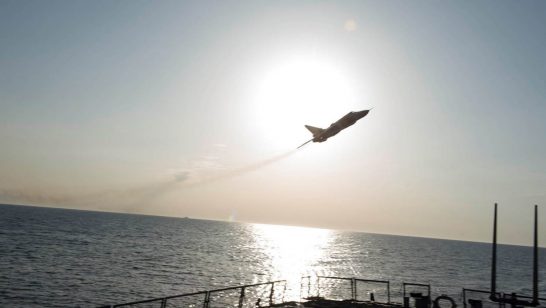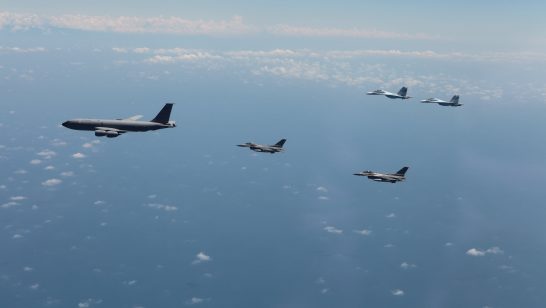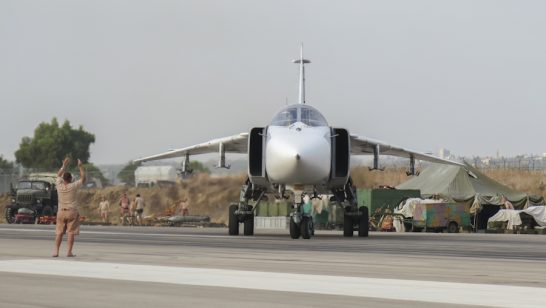
On the 18th June 2017 a US strike aircraft shot down a Syrian government fighter jet shorty after it had engaged US-backed rebel fighters in northern Syria. Russia’s reaction was swift. Moscow once again threatened to suspend the deconfliction agreement that manages encounters between US-led coalition aircraft and Russian aircraft in the skies above Syria. The Russian Ministry of Defence declared on the 19th June that “Any aircraft, including the international coalition’s planes and drones, discovered west of the river Euphrates, will be tracked by ground and air-based anti-aircraft defences as aerial targets”. As a result Australia briefly suspended operations over Syria.
Repercussions were also swiftly apparent over the Baltic Sea. On the 19th June a Russian jet flew within 1.5m of a US reconnaissance aircraft’s wingtip, whilst a Polish aircraft was warded away from an aircraft carrying Russian Defence Minister Shoigu by the latter’s fighter escort. The Swedish Ministry of Defence soon after noted a close encounter between one of its own reconnaissance aircraft and a Russian fighter. All three incidents took place in the international airspace adjacent to Russia’s Kaliningrad exclave.
Russian SU-27 Drives Away Polish F-16 Shadowing an Aircraft Carrying the Russian Defence Minister
Ahead of an expected Putin-Trump meeting on the fringes of the G20 summit in Hamburg on the 7-8 July Russia-West relations remain tense. A meeting between Russian Deputy Foreign Minister Sergei Ryabkov and US Undersecretary of State Thomas Shannon, planned for the 23 June, has already been cancelled as a “response to the overall atmosphere created by the Americans”, compounded by the expansion of the US sanctions against Russia. In such an atmosphere it is essential that unintended escalation is avoided.
Since 2014 the European Leadership Network has warned extensively about the escalatory potential of under-regulated encounters between Russian and western aircraft and ships. The agreements that cover such encounters are outdated, whilst most states that actually border Russia, including Sweden and Poland, have no such agreements at all. A November 2016 ELN report examined this danger in detail, concluding that the lack of incident management agreements between Russian and its immediate neighbours and the complete lack of effective mechanisms to manage civilian-military encounters must be addressed immediately. Failure to do so risks a military accident or incident, in turn triggering an escalation spiral that may well end in a conflict. The shooting down of a Russian aircraft by a Turkish fighter in November 2015 shows this is not a fallacy.
The possible suspension of the Syrian deconfliction agreement is equally dangerous. [1] The Russian military has regularly targeted its air defence radar systems on coalition aircraft that strayed too close to its operational air bases, but the extension of this targeting across the Syrian battlespace, combined with an increasing US willingness to engage Russian-backed Syrian regime forces on the ground in the air dramatically increases the risk of direct Russia-US engagement. There is no alternative to the existing deconfliction agreement. Agreements between Russia and leading members of the coalition on the management of air and sea incidents only apply to international airspace and waters, they have no validity in the fast moving and legally opaque situation in the skies above Syria.
Based on previous ELN proposals, below is a set of recommendations on de-escalating the tensions and strengthening the existing mechanisms for avoiding incidents:
1. The parties should ensure that all communications channels mandated by the Syrian deconfliction agreement remain active and refrain from treating their implementation as a bargaining chip.
2. There should be zero tolerance for reckless behaviour of individual military commanders, pilots and other personnel, especially by the Russian leadership. Use of dangerous military brinkmanship tactics for political signalling is a high-risk strategy, which may backfire in case of an incident.
3. The parties to the existing agreements (INCSEAs and DMAs) need to ensure that their provisions are known to and applied by their armed forces.
4. It is necessary to begin work on a thorough review and update of existing bilateral agreements in the Euro-Atlantic space, as well as to conclude additional agreements between Russia and the states most exposed to the danger of dangerous incidents and with relevant military capabilities.
5. Expert-level dialogue on the safety of military-civilian encounters over the Baltic Sea, under International Civil Aviation Organization (ICAO) cover, should be continued and expanded to other regions.
6. Re-activating or adapting the Cooperative Airspace Initiative may be helpful for preventing incidents and monitoring regional activities.
7. As long as Russia-West relations remain tense, the conclusion of multilateral agreements on preventing incidents remains difficult. Still, the modalities of such arrangements for avoiding and managing hazardous incidents should be examined in more detail by joint groups of experts, possibly as part of Track 2 effort. This includes the update of the OSCE’s Vienna Document and work towards a NATO-Russia agreement on managing dangerous incidents.
8. Political leaders should become more closely interested in the issue of avoiding incidents, and authorise civilian bureaucracies and militaries to work to improve management of incidents.
[1] Note: At the time of writing the agreement still appears to be operational.
Related ELN Content:
- Managing Hazardous Incidents in the Euro-Atlantic Area: A New Plan of Action
- Cleared for Takeoff: Dangerous Brinkmanship and the Case for the Cooperative Airspace Initiative
- Why we need the Syria Deconfliction Agreement
- Russia-West Military Incidents: Skirting the Law
- Dangerous Brinkmanship: Close Military Encounters Between Russia and the West in 2014
- Avoiding Hazardous Incidents in the Euro-Atlantic Area: Post-workshop report
The interactive map below showcases the geographical distribution of Russia – West military encounters between March 2014 and March 2015.
The opinions articulated above represent the views of the author(s), and do not necessarily reflect the position of the European Leadership Network or any of its members. The ELN’s aim is to encourage debates that will help develop Europe’s capacity to address the pressing foreign, defence, and security challenges of our time.



